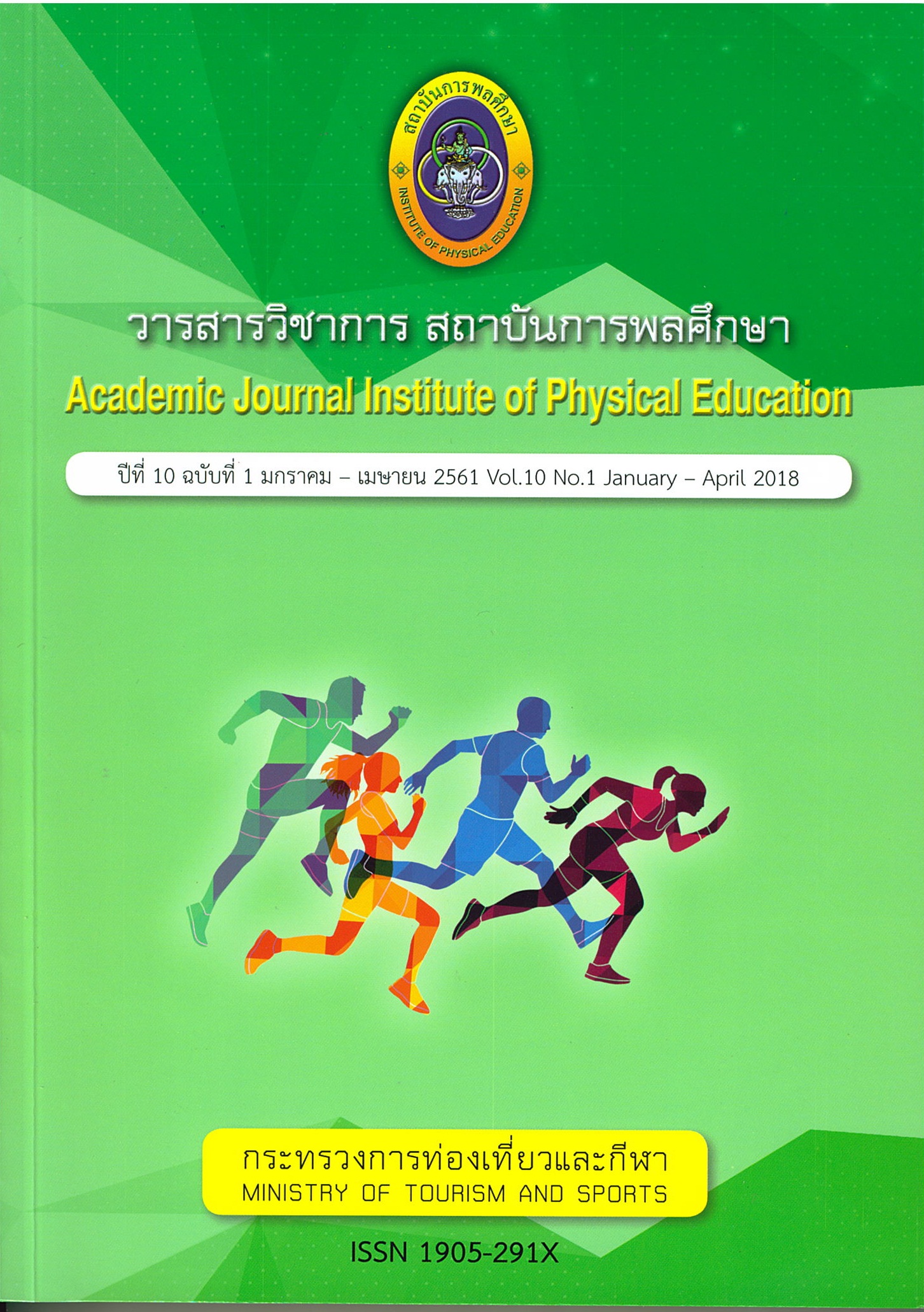Recreation Behaviors of Elderly in North East Region of Thailand
Main Article Content
Abstract
Today Thailand is in the aging society because of 14% of population are elderly according to the United Nations description. Moreover, there are the most number of the elderly in the upper North East region of Thailand. Most elderly of Thai are in the north east of country. Therefore, it is necessary to study the recreation behaviors in order to provide recreation participation for enhancing quality of life of the elderly. Do the activities to take care of the elderly to have good quality of life. The purpose of this study was to study the recreation behaviors of the elderly in the upper North East region of Thailand. The samples were 60-70 years old of the elderly club who live in the north east of Thailand. The 60-70 year-old elderly living in the upper North East region of Thailand in the elderly club using many steps in sampling. They were selected by multi-stages sampling from There were 12 selected provinces which were including Kalasin, Khon Kaen, Nakhon Phanom, Mahasarakham, Mukdahan, Roi-Ed, Sakhon Nakhon, Nonkai, Nongbualamphoo, Udon Thani, Loei, and Bungkan. There were totally 753,879 elderly who were selected from 36 districts the selected provinces in the upper North East region of Thailand. The samples of the research were 400 elderly who were calculated by Taro Yamane formula with 95% confidence level. Which were 400 persons. The research instrument was the questionnaire regarding to the recreation behavior of the elderly in the upper North East region of Thailand. The collected data were analyzed by mean scores (x) and standard deviation (S.D.) categorizing according to factors of bio-social factors.
The research findings were revealed as follows:
From the survey of the recreation behavior of the elderly in the upper North East region, the number and percentage of the elderly categorizing according to the factors of bio-social was found that 55.24% was female who mostly responded to the questionnaire. In terms of marital status, 69.52% was married and 61.58% was mostly the head of the family regarding to the family status. Sixty-one point two six percent graduated in the primary level. There was no chronic disease considered as 50.79%. Having exercise was 95.24% especially by walk (62.22%). Time was spent for exercise around 30-60 minutes considered as 58.41%. Fifty point four eight percent mostly exercised 3-4 times/ week. Active recreation activities were 90.45% by watching TV (65.71%), doing exercise (30.79%), and group discussion (28.57%) respectively. Time was spent for recreation activity around 30-60 minutes considered as 72.69%. Forty-five point seven one percent was mostly doing recreation activity 3-4 times per week.
The research findings were revealed that 55.24% of respondents were female. Most of them were married (69.52%). 69.52% of respondents were in the status of head of family. Most of them (61.26%) graduated from primary school. Half (50.79%) of respondents did not have chronic disease. The majority of respondents (95.24%) participated in exercise especially in walking (62.22%). More than half (58.41%) attended exercise in 30-60 minutes; 3-4 times a week (58.48%). Meanwhile 90.45% of respondents participated in recreation activities in 30-60 minutes (72.69%), 3-4 times a week (45.71%). Three priorities of recreation activity that respondents mostly participated in were watching television (65.71%), exercise (30.79%), and group-talking (28.57%) respectively.
In conclusion, the result from this study was useful for the elderly aging society. The government organizations, Ministry of Social Development and Human Security, Provincial Administrative Organization and Sub district Administration Organization were able to use the research result to create recreation activity for the elderly in the North East region of Thailand properly and to meet the needs of people in the North East region of Thailand to have the good quality of life.
Article Details
The published article is a copyright of the Academic Journal of Thailand National Sports University. The passage appeared in each article in this academic journal is a perspective of each author which is not related to the journal. Each author is required to be responsible for all components of his/her own article. If there are any mistakes, each author must be responsible for those mistakes on his/her own.
References
กรมกิจการผู้สูงอายุ. 2559. สถานการณ์ผู้สูงอายุ ปี 2559. (Online). สืบค้น 25 พฤศจิกายน 2559 จาก http://www.dop.go.th/main/ knowledge_detail.php?id.
กฤตติกา อาภรณ์รัตน์. 2551. ผลของการฝึกก้าวขึ้นลงในน้ำลึกด้วยรองเท้าที่มีต่อความแข็งแรงของกล้ามเนื้อต้นขาและการทรงตัวในผู้สูงวัยเพศหญิงอายุ 56-65 ปี. วิทยานิพนธ์วิทยาศาสตรมหาบัณฑิต (วิทยาศาสตร์การกีฬา) มหาวิทยาลัยเกษตรศาสตร์.
ขวัญดาว กลั่นรัตน์. 2554. การศึกษาพฤติกรรมสุขภาพผู้สูงอายุในเขตภูมิภาคตะวันตกของประเทศไทย. ดุษฎีบัณฑิต สาขาวิชาการศึกษา ตลอดชีวิตและการพัฒนามนุษย์ มหาวิทยาลัยศิลปากร.
ธราธร ดวงแก้ว และหิรัญญา เดชอุดม. 2550. พฤติกรรมการดูแลสุขภาพตนเองของผู้สูงอายุ: กรณีศึกษาตำบลโพรงมะเดื่อ อำเภอเมือง จังหวัดนครปฐม. นครปฐม: มหาวิทยาลัย ราชภัฏนครปฐม.
ประณมพร จ๋วงพานิชและกีรติ สายมณี. 2559. โครงการจัดการความรู้ สุขภาพผ่านสื่อและเทคโนโลยีออนไลน์มูลนิธิหมอชาวบ้าน : อยากมีสุขภาพดีต้องมี 3 อ. วิทยาลัยวิทยาศาสตร์และเทคโนโลยีการกีฬา มหาวิทยาลัยมหิดล. กรุงเทพฯ: บริษัท สำนักพิมพ์หมอชาวบ้าน จำกัด.
พเยาว์ พงษ์ศักดิ์ชาติ และคณะ. 2554. คู่มือการออกกำลังกายแบบรำไทยประยุกต์. วิทยาลัยพยาบาลบรมราชชนนีสระบุรี สถาบันบรมราชนก กระทรวงสาธารณสุข.
มูลนิธิสถาบันวิจัยและพัฒนาผู้สูงอายุไทย. 2556.รายงานสถานการณ์ผู้สูงอายุไทย พ.ศ.2556. Online. สืบค้น 2 ธันวาคม 2559 จาก http://www.thaitgri.org/?p=36172
วัชพลประสิทธิ์ ก้อนแก้ว. 2557. พฤติกรรมสุขภาพของผู้สูงอายุที่อาศัยในเขตเทศบาลตำบลคลองตำหรุ อำเภอเมืองชลบุรี. รัฐประศาสนศาสตรมหาบัณฑิต สาขาวิชาการบริหารทั่วไปวิทยาลัยการบริหารรัฐกิจ มหาวิทยาลัยบูรพา.
สำนักงานสถิติแห่งชาติ. 2555. ข้อมูลสถิติที่สำคัญเกี่ยวกับผู้สูงอายุ (จากสถานการณ์ผู้สูงอายุไทย : พ.ศ. 2555).
Online. สืบค้น 25 พฤศจิกายน 2559 จาก http://www.oppo.opp.go.th/info/StatP_290457.
สุทธิพงศ์ บุญผดุง. 2554. ศึกษาเรื่องการพัฒนาคุณภาพชีวิตผู้สูงอายุในท้องถิ่นโดยใช้โรงเรียนเป็นฐานตามหลักเศรษฐกิจพอเพียงระยะที่1. สถาบันวิจัยและพัฒนา มหาวิทยาลัยราชภัฏ-สวนสุนันทา.
สุปราณี แจ้งบำรุง และสิติมา จิตตินันท์. 2559. โครงการจัดการความรู้สุขภาพผ่านสื่อและเทคโนโลยีออนไลน์มูลนิธิหมอชาวบ้าน : อยากมีสุขภาพดีต้องมี 3 อ. วิทยาลัยวิทยาศาสตร์และเทคโนโลยีการกีฬา มหาวิทยาลัยมหิดล. กรุงเทพฯ: บริษัท สำนักพิมพ์หมอชาวบ้าน จำกัด.
อริสรา สุขวัจนี. 2554. ผู้สูงอายุกับการออกกำลังกาย. เอกสารประกอบการสอน สาขาวิชาการพยาบาลผู้ใหญ่ คณะพยาบาลศาสตร์ มหาวิทยาลัยศรีนครินทรวิโรฒ.
อังชัน จึงสกุลวัฒนา. 2550. ปัจจัยที่มีผลต่อพฤติกรรมสุขภาพของผู้สูงอายุวัยท้ายในเขตองค์การบริหารส่วนตำบลวังโตนด อำเภอ นายายอาม จังหวัดจันทบุรี. ปริญญารัฐประศาสนศาสตรมหาบัณฑิต สาขาวิชาการปกครองท้องถิ่น วิทยาลัยการปกครองท้องถิ่นมหาวิทยาลัยขอนแก่น.
อารดา ธีระเกียรติกำจร. 2554. ปัจจัยที่ส่งเสริมคุณภาพชีวิตของผู้สูงอายุคุณภาพชีวิตผู้สูงอายุในเขตเทศบาลตำบลสุเทพอำเภอเมือง จังหวัดเชียงใหม่. วิทยานิพนธ์เศรษฐศาสตรมหาบัณฑิต สาขาวิชาเศรษฐศาสตร์ มหาวิทยาลัยเชียงใหม่.
Caplan, A.1974. A Subjective Measure of Well Being. American Psychologist; 31: 117-121.
Cruz, A. D. 1986. One Loneliness and the Elderly. Journal of Gerontological Nursing. 12(6): 22-27.
King, Oman, Brassington, Bliwise and Haskell.1997. Moderate-intensity exercise and self-rated quality of sleep in older adults. Jan 1; 277(1):32-7.
Morrow, J. R.P., A.W. Jackson, J.G. Disch and D.P. Mood. 2000. Measurement and Evaluation in Human Performance. Illinois: Human Kinetics;
Sobczak .1997. Music and movement to exercise older people. Apr 9-15;93(15):46-9.
Tatsumi .1997. Increased serum interleukin-1 and interleukin-6 in elderly, chronic chizophrenic patients on stable antipsychotic medication. Jun; 1(2): 171–177.
Taylor, J.R.1992. Sagital and Horizontal Plane Movement of Human Lumbar Vertebral Column in Cadavers and in the Liver. Rheumatology and Rehability; 19: 223-232.
Yamane, T. (1973). Statistic: An Introductory Analysis. 3 rd ed. New York: Harper and Row.


